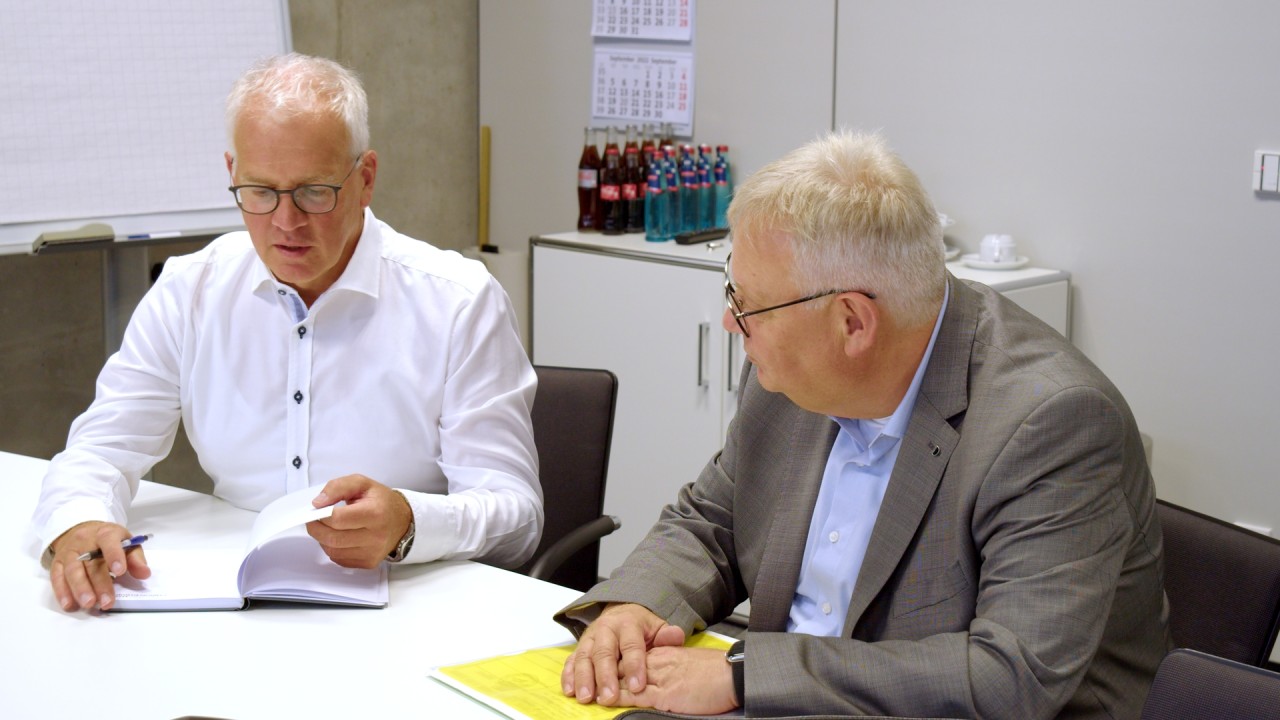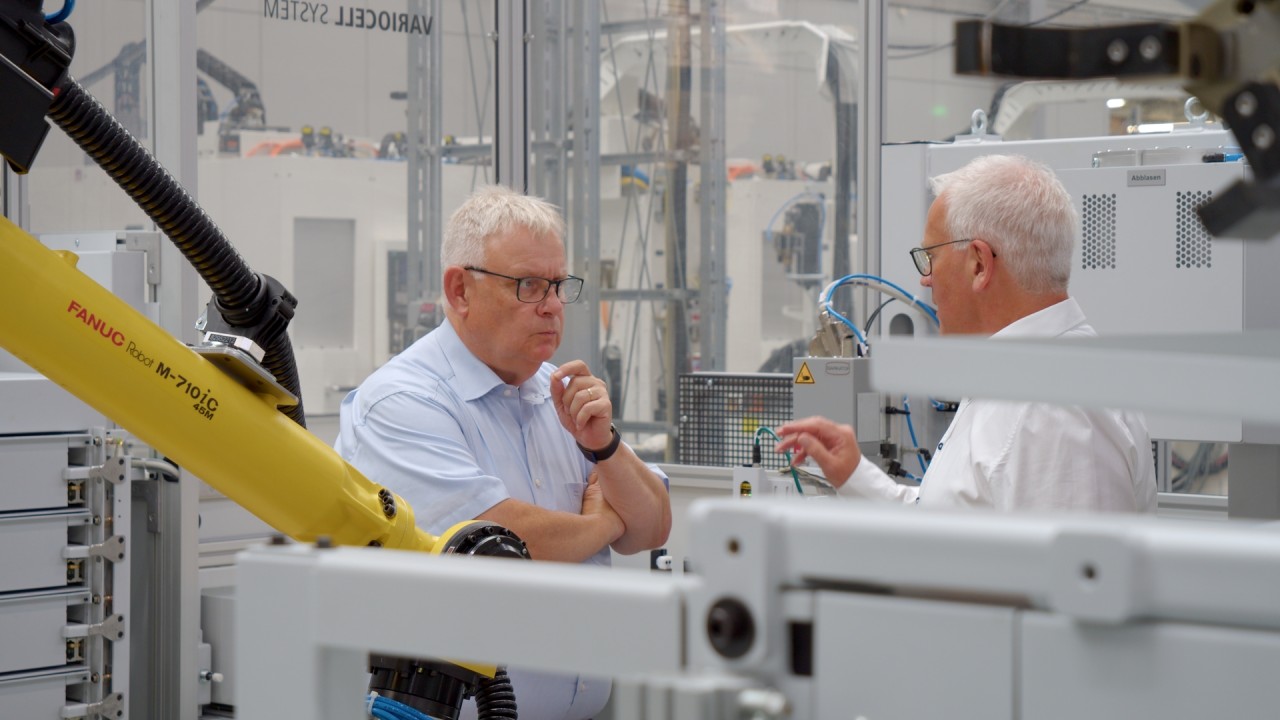But what are the priorities in Spaichingen and Tuttlingen, Germany, and how can machining, assembly and production processes be made even more efficient? And which projects are in the pipeline? Michael Greidenweis and Thomas Marquardt discuss this in the video, and further information is provided in the interview.
Mr. Greidenweis, Mr. Marquardt: How will customers of the CHIRON Group benefit from the new brand GREIDENWEIS? And, by the same token, what are the advantages for the customers of Greidenweis, which is now a subsidiary of the Group?
Michael Greidenweis: Our common goal is to provide highly productive, individualized complete solutions. As soon as the takeover was announced, we saw high levels of interest. We have received project requests from the agricultural and wood industry and from the automotive sector. A new thing for us is that these project requests focus on the machining center and require the integration of further steps after machining, such as the loading and unloading, washing, testing, screwing, gluing, assembling. Our expertise is needed here. Another plus point: Due to our integration into the CHIRON Group, we receive significantly more inquiries and, with access to the expertise in the Group, we can jointly tackle new, exciting projects, for example in the areas of medical technology, drive technology, e-motors and fuel cells.
Thomas Marquardt: Together, we are strengthening our field of expertise in automation, successively extending our »modules« and can tackle and optimally support larger projects. Until now, our automation solutions have focused on the loading and unloading of workpieces after the machining process. In the automotive industry, interlinking after machining has long been an issue. Now, with the help of Greidenweis, we can transfer this knowledge to other industries and make machining, assembly and production processes even more efficient with innovative automation solutions. This applies to applications ranging from high-volume parts production on a single machining center to complex production lines – starting with blanking, followed by machining, through to end-of-line testing.

How have customer requirements and demand for automation changed over the years and what is the focus now?
Michael Greidenweis: Even today, the focus is of course on the hardware, but integration of the automation modules in the superordinate systems is becoming increasingly important. The key words here are software, control technology, networked production, Industry 4.0. When I started, you had to dig deep into the design and develop everything yourself. Today, it's more like Lego – it's about adapting existing components to specific projects and bringing them together to form a functioning unit.
Thomas Marquardt: For us, it began back in 1996 with the automatic replacement of devices on the Flexline. The VarioCell Uno launched in 2008 was the first automation system for replacing workpieces. Automation today turns a machining center into an autonomous, highly productive and flexible manufacturing unit. Highly automated processes are increasingly in demand, in order to consistently achieve the best quality, even during unattended shifts. Of course, especially in Germany, other factors that are driving demand are the increasing wage costs and skills shortages. We implement turnkey solutions with everything that goes hand in hand with them: CNC machines, tools, machining process, clamping devices and automation. The numbers speak for themselves: Four years ago, the share of automation in project machines was 50 percent, but this year it is over 80 percent. We also have more manpower to tackle projects now. In 2008 there were just three of us and now we have 31 employees in engineering plus a further six to eight in applications assembly.
Can you describe the collaboration between Spaichingen and Tuttlingen in detail? What joint projects are underway?
Thomas Marquardt: The collaboration is running at two levels – operational on the one hand and strategic on the other. At operational level, product planning supports the integration process, while at the automation team in Tuttlingen we come into play on the technical side, in other words with project content, technical agreements, project coordination. For example, for the development of a bar feeder, in which the specialists from Spaichingen are involved. We also have other projects underway, in which we support each other. Greidenweis currently provides services for the assembly of memory modules as well as for project planning, design and assembly of special modules.
Michael Greidenweis: The second level is the Executive Board. We meet here once a month to define targets and strategies. And it's going very well. All superordinate integration processes, from IT to accounting, are running smoothly, and some have already been completed. The acceptance by employees in the Automation department is also very positive. It's all going really well and everyone is on the same wavelength.

Mr. Greidenweis, one last question: Which arguments tipped your decision in favor of the CHIRON Group in your selection process for the company succession?
Michael Greidenweis: There were several. The CHIRON Group was of particular interest to us in terms of the products and the objective of the collaboration – automation after machining. The spatial proximity is also a plus. Automation is complex and frequent discussions are required. This can be done quickly and easily where there is a distance of just 15 kilometers between us. What I and the employees here in Spaichingen found particularly important was that we didn't want our family company to be sold to an anonymous investor somewhere abroad that only cares about the numbers. Nor to a large corporation where our expertise would be »swallowed up«. The CHIRON Group is a network of strong brands, all of which have their own brand essence and yet all of which are integrated in the big picture. The CHIRON Group also represents the values of a family company, through its long-term membership of Holding Hoberg & Driesch, and so we feel we are in the best of hands here.
You can learn more about »A new dimension of automation« during a presentation at the CHIRON Group OPEN HOUSE on Wednesday, May 10. Click here for the full lecture program.
You can read more about GREIDENWEIS as a »brand of the CHIRON Group« on the new corporate website, and more about the additional fields of expertise of edge folding, joining, bonding and laminating on the brand website: www.greidenweis-sondermaschinen.de/en

